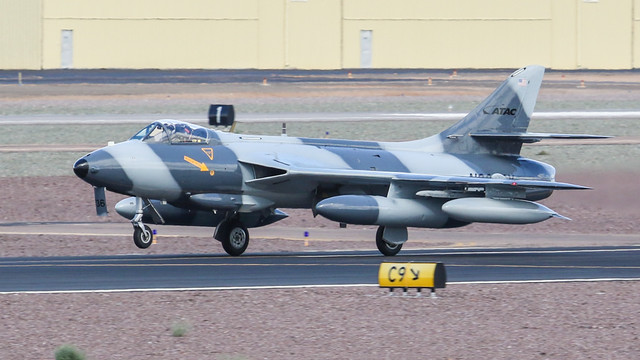I’ve been wondering about the private aggressor jet that crashed last week during an air warfare exercise in Hawaii. The exercise, unpublicized prior to the crash, involved Air National Guard F-22s and F-15s, plus Navy F/A-18s. The contractor, Airborne Tactical Advantage Company, according to its website, provides “realistic air combat training” to military pilots. ATAC operates three no-longer-in-service foreign aircraft: the British Mk-58 Hawker Hunter, the Czechoslovakian L-39 Albatros, and the Israeli F-21 Kfir.
Of the three aircraft, only one, the 1970s-era Kfir, is anywhere close to the kind of enemy jet fighter our pilots might encounter in combat today: a third-generation supersonic fighter with a radar and air-to-air weapons capability. The Albatros, first flown in 1968, is a small subsonic trainer with no radar, no gun, and limited missile-carrying capability; the Hunter, also subsonic, dates from the 1950s and is fitted with a small range-finding radar for air-to-air gunnery plus wing pylons for short-range heat-seeking missiles.

We should have it so easy, going up against an enemy air force equipped with 1950s technology … even North Korea has more advanced equipment. But you know what they say: we always train to fight the last war we had (and in this case I feel like we’re still training for Vietnam).
So what value does the Air Force and Navy get from private aggressor contractors? I have some experience with them: when I flew Eagles at Kadena in the early 1990s, the wing hosted a civilian contractor flying F-86 Sabres. We flew with the Sabres all the time (and partied at the club with the pilots, middle-aged former military jet jockeys), but they weren’t aggressors … they towed the darts we used to practice aerial gunnery. Those Sabres were the equivalent of the Hawker Hunter that crashed in Hawaii earlier this month.
In addition to the Kfirs, Albatroses, and Hunters operated by ATAC, other private adversary training contractors fly Swedish Drakens, French Mirages (the jet Israel’s Kfir was based on), and American A-4 Skyhawks and F-5 Tigers. Of all of these, only the Kfirs and Mirages come close to simulating the air-to-air threats we might encounter in combat today.
I don’t know what type or level of training ATAC was providing with the jet it lost, but am guessing it carried some kind of electronic warfare & countermeasures pod to jam radars and activate warning sensors aboard the military fighters it flew against. That’s valid training, and in fact the same contractor that provided the F-86 dart tow jets at Kadena in the 1990s operated a pair of Lear Jets that were used for that exact purpose. I get the impression, though, reading between the lines of various reports about the accident at Hickam, that our forces were engaging in dogfights with the Hunter, and frankly I don’t see much value in that.
The USAF and Navy used to (and still do, to a much smaller extent) have their own organic “aggressor” units with active duty military pilots trained in adversary tactics, but the trend is toward private contractors because there’s a pilot shortage and the military doesn’t want to pull its own pilots from front-line cockpits. Or so they say … to my knowledge the real impact of this shortage is on non-flying headquarters desk jobs that for various reasons (frequently bullshit ones) only pilots can perform. Obviously, using civilian contractors is a way around the problem, but I wish they could fly modern aircraft, ideally Russian, Chinese, or European fighters.
In my day the USAF ran a super-secret program (finally declassified in 2006, which is why I can write about it now) called Constant Peg from an airstrip near Tonopah, Nevada, where it had a small squadron of MiG-21 Fishbeds and MiG-23 Floggers. Aircrews at Nellis AFB’s Fighter Weapons School, along with visiting aircrews taking part in Red Flag air war exercises, were able to go out in ones and twos to engage with the MiGs over Tonopah. It wasn’t adversary training, not really … it was a familiarization program, as in “here’s what a MiG looks like in the air, here’s how it flies and fights, here are its strengths and weaknesses” … the idea being to get the buck fever out of your system before you saw the real thing in combat. Great training, but strictly limited (as in you only got to do it once), rigidly scripted, nothing like actual air combat.
When the Soviet Union broke up there was a window of opportunity when we could have bought squadron-sized numbers of MiG-29s and Su-27s, aircraft that at the time were roughly equivalent to early versions of our own F-15, F-16, and F/A-18, aircraft that even today still pose a credible threat. We took a pass on the deal. IMHO that was a mistake, leaving us where we are now, increasingly reliant on private contractors to provide small numbers of antiquated aggressor jets with at best limited air-to-air capabilities, a far cry from the 1970s and 80s when the services had their own organic aggressor squadrons, and an even farther cry from what might have been.
But hey, there could always be another Vietnam, right?
Paul, good concise description of a worrisome problem at hand, thanks,
I don’t think a Hunter could even take on a MiG-17 much less a supersonic MiG-19 or ’21. Sounds more like we’re training to fight the Korean conflict over again. Civilian jobs program for retired military pilots? Well connected contractors cahooting with plugged in military officers who are planning post retirement gigs? Nobody listened to Ike about the MI Complex. Not even Ike.
‘Tod’ recently posted…ERCO Ercoupe Light Sport Aircraft: Antique Flying Art